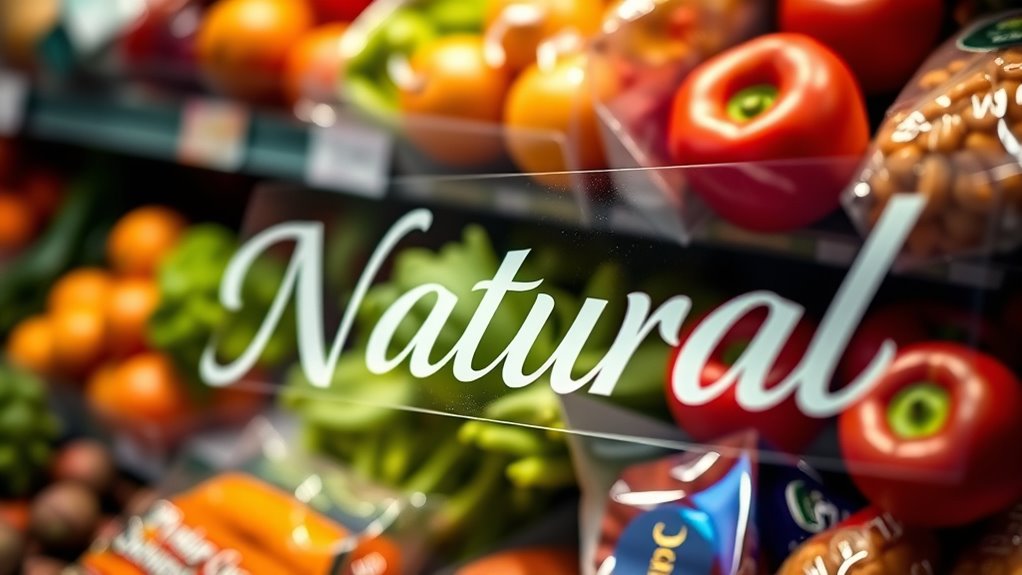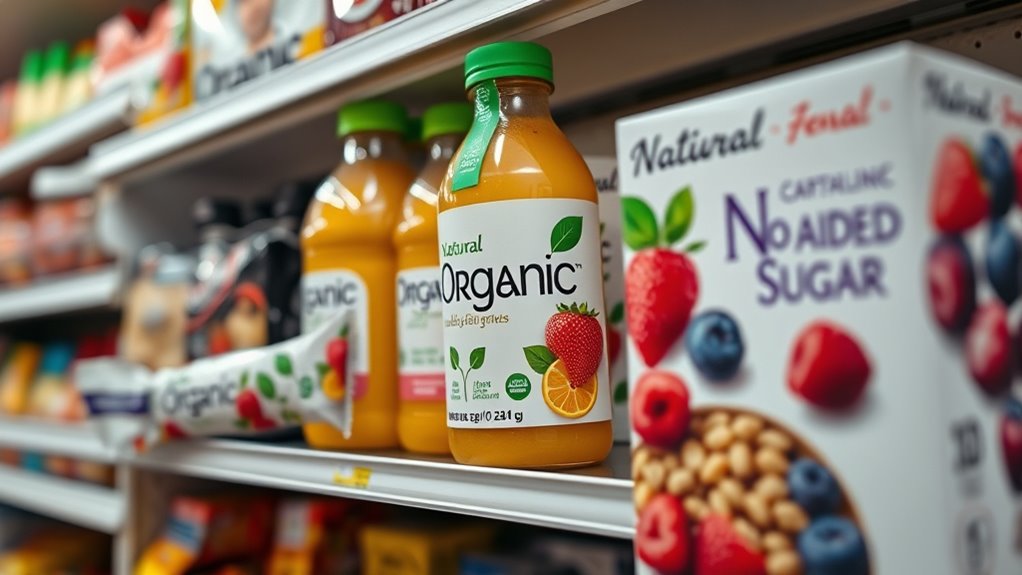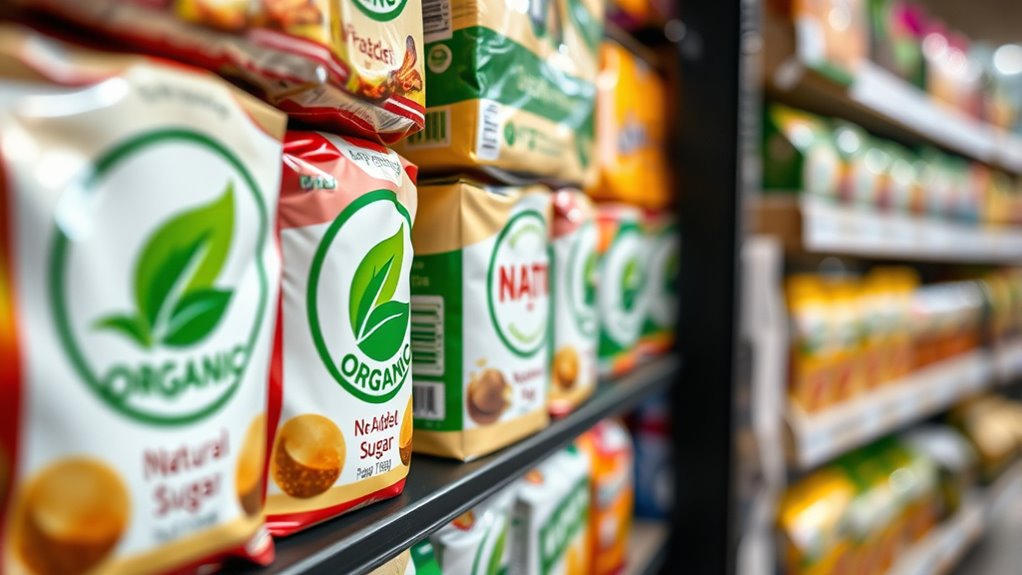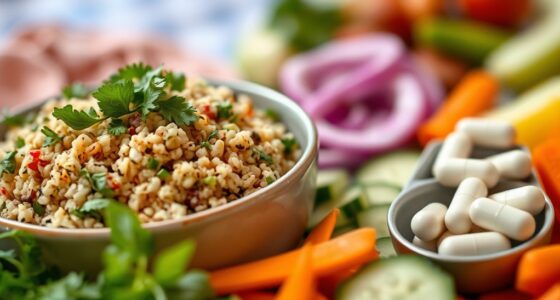When you see labels like “natural,” “organic,” and “no added sugar,” know that these terms can be misleading or vary based on regulations. “Natural” doesn’t guarantee health benefits or minimal processing, while “organic” indicates standards for pesticide use and farming practices verified by certifications. “No added sugar” means no extra sugar was added but doesn’t mean the product is low in natural sugars. To make smarter choices, exploring what these labels really mean can help you spot trustworthy products.
Key Takeaways
- “Natural” can be misleading, as it often includes processed foods with artificial ingredients; it doesn’t guarantee minimal processing or health benefits.
- “Organic” indicates farming without synthetic pesticides or GMOs, but it doesn’t ensure complete purity or absence of contaminants.
- “No Added Sugar” means no extra sugars added during processing, but natural sugars from ingredients like fruits still count.
- Always check ingredient lists and certification logos to verify label claims and avoid marketing deception.
- Recognizing reputable seals and understanding label terminology helps make informed, healthier food choices.
Understanding the Term “Natural” on Food Labels

Have you ever wondered what “natural” really means on a food label? The label language surrounding “natural” can be confusing because companies often use this term as a marketing tactic. Many consumers assume “natural” means the product is healthy or minimally processed, but that’s not always true. Food manufacturers may use “natural” to appeal to health-conscious buyers without strict regulations backing the claim. In fact, the term isn’t tightly regulated in many regions, so it can be applied to foods with added sugars, artificial ingredients, or other additives. Understanding this marketing tactic helps you see beyond the label language and make more informed choices. Always check ingredient lists and other details rather than relying solely on “natural” branding. Additionally, sound healing science reveals that perceptions created by labels can influence how we experience taste and health benefits, so being informed helps you make better choices.
What Does “Organic” Really Signify?

Ever wonder what “organic” truly means when you see it on a food label? Organic certification guarantees that the product meets specific standards set by regulatory bodies, focusing on sustainability and natural farming practices. Organic foods are grown without synthetic pesticides, fertilizers, or genetically modified organisms. This process often involves strict regulatory oversight to ensure compliance. Additionally, organic farming emphasizes soil health and biodiversity, which can contribute to the overall nutritional quality of the food. This means you’re less likely to find pesticide residues on organic produce compared to conventional options. However, organic farmers can still use natural pesticides, so residues may still be present, just from approved substances. Certification requires regular inspections and strict adherence to guidelines, giving you confidence in the product’s integrity. Ultimately, “organic” signifies a commitment to environmentally friendly practices and reduced chemical exposure, but it doesn’t necessarily mean the product is pesticide residue-free. Understanding organic standards can help you make more informed choices about the foods you purchase.
The Meaning Behind “No Added Sugar” Claims

When a product claims “No Added Sugar,” it means no extra sugar has been added during processing, but natural sugars still exist. It’s important to recognize that some foods contain hidden sugars from ingredients like fruit juices or syrups. Reading labels carefully helps you understand whether a product is truly low in sugar or if natural sources are the only sugars present. Additionally, understanding refrigerant management in heat pump systems highlights the importance of environmentally responsible practices in food processing equipment. Being aware of sugar content in ingredients can further aid in making healthier choices. Monitoring sugar levels in packaged foods can help consumers better control their intake and maintain a balanced diet. Moreover, being familiar with anti-aging effects of products like eye patches can influence skincare decisions and overall appearance.
Sugar Addition Definition
What does “no added sugar” really mean on a food label? It indicates that the product contains no sugars added during processing or packaging. However, this doesn’t mean the food is free of all sugars; it may still have natural sugars from ingredients like fruits or dairy. The term focuses on sugar addition, which is the act of including extra sugars beyond those naturally present. Products labeled “no added sugar” aim to reduce overall sugar intake, but manufacturers can still use ingredients that contain naturally occurring sugars. It’s important to read ingredient lists carefully because “no added sugar” doesn’t guarantee the product is low in sugar overall. Understanding sugar addition helps you make more informed choices about what you’re really eating. Additionally, being aware of natural sugars and their effects can help you better manage your dietary intake.
Natural Sugar Sources
Though a product may have a “no added sugar” label, it can still contain natural sugars from ingredients like fruits, dairy, or certain vegetables. These natural sweeteners provide fruit sugars that occur naturally in whole foods. When reading labels, picture these sources:
- Juicy apples and berries bursting with fruit sugars
- Creamy milk and yogurt containing natural lactose
- Carrots and sweet potatoes offering subtle vegetable-derived sweetness
- Dried fruits like raisins or dates packed with concentrated natural sugars
Understanding that natural sweeteners are inherent in many whole foods helps you see that “no added sugar” doesn’t mean sugar-free. Instead, it indicates the absence of processed or artificial sugars, highlighting the natural sources that contribute fruit sugars and other natural sweeteners. Recognizing these natural ingredients can help consumers better interpret label claims and make informed choices, especially considering how natural sugar content varies among different foods. Being aware of natural sugar sources also helps in managing overall sugar intake for a healthier diet.
Hidden Sugar Ingredients
Have you ever noticed that some products labeled “no added sugar” still taste unexpectedly sweet? That’s because manufacturers often use artificial sweeteners, which mimic sugar’s sweetness without adding actual sugar. These substitutes can be found in beverages, snacks, and even sauces, making it seem like there’s no sugar involved. Additionally, some products contain added preservatives that help prolong shelf life but can also mask the presence of hidden sugars or artificial sweeteners. It’s important to read ingredient lists carefully—sugar can hide under names like glucose, fructose, or syrups, even if the label claims “no added sugar.” Understanding food labeling practices can help consumers better identify what’s really in their food and avoid unintended consumption of sweeteners or preservatives. Transparency in ingredient disclosure, such as detailed labeling and cookie policies, can help consumers make more informed choices. Being aware of hidden ingredients like sugar substitutes and preservatives is key to making healthier decisions.
Common Misconceptions About Food Label Terms

Many labels like “natural” can be misleading, as they don’t always mean the product is free of artificial ingredients. Similarly, seeing “organic” doesn’t automatically guarantee the food is pure or free of contaminants. Understanding what these terms truly mean helps you make smarter, more informed choices. For example, food labeling regulations encompass a broad range of standards that define how terms like “organic” and “natural” are used on packaging. It’s also important to recognize that farmhouse-style decor often incorporates authentic elements that reflect traditional craftsmanship, which can influence perceptions of product authenticity.
“Natural” Is Not Always Natural
The word “natural” on food labels can be be misleading because it doesn’t always mean what you might assume. Many products labeled as natural undergo extensive food processing, which can strip away nutrients or add artificial ingredients. When you see “natural,” think beyond simple ingredients—consider the hidden label jargon. For example: 1. The fruit snack might contain artificial sweeteners. 2. The granola bar could be loaded with preservatives. 3. The juice might have added flavors or colorings. 4. The snack chips could be made from heavily processed oils. Label jargon often masks the truth about food processing, making “natural” a vague term. It’s vital to look past the label and examine ingredient lists to truly understand what’s inside. Don’t assume “natural” guarantees purity or minimal processing. Additionally, understanding food labeling regulations can help you make more informed choices. Recognizing the distinction between natural and minimally processed foods is key to better dietary decisions. Being aware of processing techniques used in food production can further clarify what “natural” truly entails. Moreover, consumer education about these labels can empower you to make healthier selections.
“Organic” Doesn’t Guarantee Purity
While “natural” labels can be misleading due to heavy processing, believing that “organic” always means pure is a common misconception. Organic certification focuses on farming practices that avoid synthetic pesticides and fertilizers, but it doesn’t eliminate pesticide residues entirely. Some organic produce may still carry traces of pesticides from nearby conventional farms or environmental contamination. Additionally, organic farming doesn’t guarantee freedom from all contaminants or impurities. It’s important to remember that organic standards prioritize sustainable and eco-friendly methods, not absolute purity. So, even if a product is labeled organic, it’s wise to be cautious and understand that purity isn’t guaranteed. Always consider other factors, like testing and sourcing, to truly assess a food’s cleanliness and safety.
How to Recognize Reliable Labels and Certifications

How can you tell if a food label is trustworthy? Start by checking for official label certification from reputable organizations. Reliable labels often feature recognizable logos or seals that indicate strict standards. To verify authenticity, do scam verification by visiting the certifier’s website or contacting them directly. Look for these clues:
Check for trusted certification logos and verify authenticity through official websites or contacts.
- Clear, recognizable certification logos from trusted agencies.
- Consistent language and detailed information on ingredients and sourcing.
- Absence of misleading claims or vague wording.
- Easy access to verification tools, like QR codes or official databases.
- Vetted – Best Small Wood Stoves to ensure the quality and safety of the product.
Tips for Making Informed Choices Based on Labels

Once you’ve identified trustworthy labels and certifications, you can use that information to make smarter choices at the grocery store. Start by understanding common label jargon, so you’re not fooled by marketing tactics. For example, terms like “all-natural” or “fresh” can be misleading if not backed by certifications. Always read the fine print and compare ingredient lists, rather than relying solely on eye-catching claims. Look for third-party certifications like USDA Organic or Non-GMO Project, which offer more reliable assurance. Be cautious of marketing tactics that aim to attract attention without delivering real health benefits. Making informed choices means questioning what you see on packaging and doing a quick background check when in doubt. This approach helps you select genuinely healthy, transparent products.
Frequently Asked Questions
Are “Natural” Labels Regulated by Any Official Authority?
You might wonder if “natural” labels are regulated by official authorities. Currently, regulatory standards for “natural” labels aren’t consistent; food labeling laws vary by country and aren’t strictly enforced. This means companies can use “natural” without strict proof, so you need to read ingredient lists carefully. To protect yourself, look for certifications or clarifications on packaging, and stay informed about how different regions regulate food labeling laws.
Can “Organic” Foods Contain Pesticides or Artificial Ingredients?
Ever wonder if organic foods are completely free from pesticide residues or artificial additives? The truth is, they can contain both, but in much smaller amounts than conventional options. Organic standards limit synthetic chemicals, yet some natural pesticides are permitted. So, while organic foods reduce chemical exposure, they aren’t entirely free from pesticides or artificial ingredients, making it essential to stay informed and scrutinize labels carefully.
Does “No Added Sugar” Mean the Product Is Completely Sugar-Free?
When you see “no added sugar,” it doesn’t mean the product is completely sugar-free. It means no sugar was added during processing, but natural sugars like those in fruit or dairy still exist. Sugar alternatives might be used to sweeten the product, but added sugar definitions focus only on extra sugars, not naturally occurring ones. So, always check labels carefully if you want a truly sugar-free product.
How Can I Spot Misleading or False Food Label Claims?
Think of misleading packaging as a magician’s illusion—you’re meant to be fooled by marketing buzzwords. To spot false claims, read beyond the front label; check ingredients and nutrition facts. For example, “natural” can mean little, “no added sugar” might still have natural sugars. Trust your instincts and research reputable sources. Being vigilant helps you see through marketing tricks and make truly informed choices.
Are There Any Hidden Ingredients to Watch Out for in Labeled Foods?
When checking labeled foods, watch out for hidden additives that might be buried in ingredient lists, even if the packaging seems straightforward. These hidden ingredients can sometimes be used to make misleading claims about health benefits or flavor. Always read labels carefully and research unfamiliar terms. By staying vigilant about hidden additives, you safeguard yourself from falling for misleading claims and ensure you’re making truly informed food choices.
Conclusion
Remember, labels can be tricky, but with a little knowledge, you can make smarter choices. Don’t be fooled by buzzwords like “natural”—they aren’t always what they seem. Focus on certified labels and read the fine print. It’s worth the effort to understand what you’re really eating. After all, taking control of your food choices today helps you stay healthier tomorrow. So, stay informed and trust what’s behind the labels!









